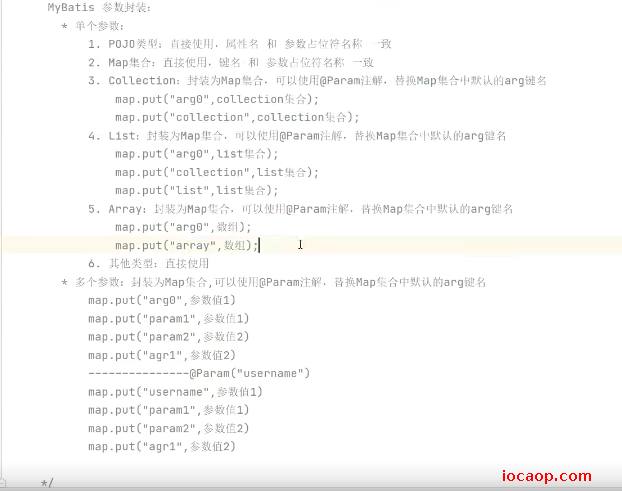mybatis
5-1-mybatis快速入门
01-简介
- 一款优秀的持久层框架、用于简化JDBC开发
- iBatis
- 官网:点击跳转
持久层:
- 负责将数据保存到数据库的那一层代码
- JavaEE三层架构:表现层、业务层、持久层
框架:
- 半成品软件、可重用、通用的软件基础代码模型
- 在框架的基础之上构建软件编写更加高效、规范、通用、可扩展
JDBC缺点:
- 硬编码:数据库连接信息经常变动,JDBC那套代码我们是写死的字符串、sql也存在硬编码、
- 操作繁琐:手动设置参数、手动封装结果集
mybatis免除了几乎所有的JDBC代码,以及设置参数和获取结果集的工作。
02-环境搭建
需求:
- 创建user表、添加数据
- 创建模块、导入坐标
- 编写Mybatis核心配置文件->替换连接信息、解决硬编码问题
- 编写SQL映射文件->统一管理SQL语句,解决硬编码问题
- 编码
- 定义pojo类
- 加载核心配置文件、获取
SqlSessionFactory对象 - 获取
SqlSession对象,执行SQL语句 - 释放资源
ddl:
create database mybatis;
use mybatis;
drop table if exists tb_user;
create table tb_user(
id int primary key auto_increment,
username varchar(20),
password varchar(20),
gender char(1),
addr varchar(30)
);
INSERT INTO tb_user VALUES (1, 'zhangsan', '123', '男', '北京');
INSERT INTO tb_user VALUES (2, '李四', '234', '女', '天津');
INSERT INTO tb_user VALUES (3, '王五', '11', '男', '西安');
创建module,导入依赖:
<dependencies>
<!-- mybatis -->
<dependency>
<groupId>org.mybatis</groupId>
<artifactId>mybatis</artifactId>
<version>3.5.5</version>
</dependency>
<!-- mysql 驱动 -->
<dependency>
<groupId>mysql</groupId>
<artifactId>mysql-connector-java</artifactId>
<version>5.1.32</version>
</dependency>
<dependency>
<groupId>junit</groupId>
<artifactId>junit</artifactId>
<version>4.13</version>
<scope>test</scope>
</dependency>
<!-- 添加slf4j日志api -->
<dependency>
<groupId>org.slf4j</groupId>
<artifactId>slf4j-api</artifactId>
<version>1.7.20</version>
</dependency>
<!-- 添加logback-classic依赖 -->
<dependency>
<groupId>ch.qos.logback</groupId>
<artifactId>logback-classic</artifactId>
<version>1.2.3</version>
</dependency>
<!-- 添加logback-core依赖 -->
<dependency>
<groupId>ch.qos.logback</groupId>
<artifactId>logback-core</artifactId>
<version>1.2.3</version>
</dependency>
</dependencies>
日志配置:
<?xml version="1.0" encoding="UTF-8"?>
<configuration>
<!--
CONSOLE :表示当前的日志信息是可以输出到控制台的。
-->
<appender name="Console" class="ch.qos.logback.core.ConsoleAppender">
<encoder>
<pattern>[%level] %blue(%d{HH:mm:ss.SSS}) %cyan([%thread]) %boldGreen(%logger{15}) - %msg %n</pattern>
</encoder>
</appender>
<logger name="com.lzc" level="DEBUG" additivity="false">
<appender-ref ref="Console"/>
</logger>
<!--
level:用来设置打印级别,大小写无关:TRACE, DEBUG, INFO, WARN, ERROR, ALL 和 OFF
, 默认debug
<root>可以包含零个或多个<appender-ref>元素,标识这个输出位置将会被本日志级别控制。
-->
<root level="DEBUG">
<appender-ref ref="Console"/>
</root>
</configuration>
03-核心配置文件
参考官网,创建mybatis-config.xml,点击跳转
<?xml version="1.0" encoding="UTF-8" ?>
<!DOCTYPE configuration
PUBLIC "-//mybatis.org//DTD Config 3.0//EN"
"https://mybatis.org/dtd/mybatis-3-config.dtd">
<configuration>
<environments default="development">
<environment id="development">
<transactionManager type="JDBC"/>
<!--数据库配置信息-->
<dataSource type="POOLED">
<property name="driver" value="com.mysql.jdbc.Driver"/>
<property name="url" value="jdbc:mysql://www.iocaop.com:3306/mybatis?serverTimezone=UTC&useSSL=false&useServerPrepStmts=true"/>
<property name="username" value="root"/>
<property name="password" value="911823"/>
</dataSource>
</environment>
</environments>
<mappers>
<!--加载SQL映射文件-->
<mapper resource="mapper/UserMapper.xml"/>
</mappers>
</configuration>
创建tb_user对应的实体类:
/**
* 用户
*
* @author lzc
* @date 2023/07/19
*/
@Data
public class User {
/**
* id
*/
private Integer id;
/**
* 用户名
*/
private String username;
/**
* 密码
*/
private String password;
/**
* 性别
*/
private char gender;
/**
* 地址
*/
private String addr;
}
创建UserMapper.xml,需要将这个xml文件加载,在mybatis-config.xml中已经做过了。
<?xml version="1.0" encoding="UTF-8" ?>
<!DOCTYPE mapper
PUBLIC "-//mybatis.org//DTD Mapper 3.0//EN"
"https://mybatis.org/dtd/mybatis-3-mapper.dtd">
<mapper namespace="test">
<select id="selectAll" resultType="com.lzc.mybatis.pojo.User">
select * from tb_user;
</select>
</mapper>
之类没有Mapper接口,所以命名空间使用test
编写测试类:
public class MybatisDemo {
public static void main(String[] args) throws Exception {
// 加载核心配置文件
String resource = "mybatis-config.xml";
InputStream inputStream = Resources.getResourceAsStream(resource);
SqlSessionFactory sqlSessionFactory = new SqlSessionFactoryBuilder().build(inputStream);
// 获取sqlSession对象
SqlSession sqlSession = sqlSessionFactory.openSession();
List<User> userList = sqlSession.selectList("test.selectAll");
System.out.println("userList = " + userList);
}
}
sqlSession.selectList("test.selectAll");这一步直接使用命名空间.id就可以执行mapper.xml中对应的SQL语句
执行结果:

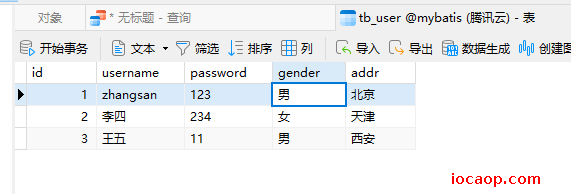
05-Mapper代理开发
在上面我们已经通过sqlSession实现了通过namespace和id,执行SQL,查询数据库,但是存在问题:namespace和id存在硬编码问题。
参考官网:

目的:
- 解决原生方式中的硬编码问题
- 简化后期执行SQL
步骤:
- 定义SQL映射文件同名的Mapper接口,并且将Mapper接口和SQL映射文件放在同一目录下
- 设置SQL映射文件中的namespace为Mapper接口全限定名
- 在Mapper接口中定义方法,方法名就是SQL映射文件中SQL语句的id,并且保持参数类型和返回值类型一致。
- 编码:
- 通过SqlSession的getMapper方法获取Mapper接口的代理对象
- 调用对应的方法完成SQL执行
如果Mapper接口每次和SQL映射文件名称相同,并且在同一目录下,可以通过扫包的方式简化SQL映射文件的加载
<package name="com.lzc.mybatis.mapper"/>
创建接口,与SQL映射文件同名,并定义方法,与需要执行的SQL的id一致:
public interface UserMapper {
/**
* 查询所有用户
*
* @return {@link User}
*/
List<User> selectAll();
}
修改SQL映射文件的namespace:
<?xml version="1.0" encoding="UTF-8" ?>
<!DOCTYPE mapper
PUBLIC "-//mybatis.org//DTD Mapper 3.0//EN"
"https://mybatis.org/dtd/mybatis-3-mapper.dtd">
<mapper namespace="com.lzc.mybatis.mapper.UserMapper">
<select id="selectAll" resultType="com.lzc.mybatis.pojo.User">
select * from tb_user;
</select>
</mapper>
编码,获取代理对象,执行方法:
public class MybatisDemo02 {
public static void main(String[] args) throws Exception {
// 加载核心配置文件
String resource = "mybatis-config.xml";
InputStream inputStream = Resources.getResourceAsStream(resource);
SqlSessionFactory sqlSessionFactory = new SqlSessionFactoryBuilder().build(inputStream);
// 获取sqlSession对象
SqlSession sqlSession = sqlSessionFactory.openSession();
UserMapper mapper = sqlSession.getMapper(UserMapper.class);
List<User> userList = mapper.selectAll();
System.out.println("userList = " + userList);
// 释放资源
sqlSession.close();
}
}
执行可以看到:这是代理对象,通过代理对象调用对应的方法,相当于:
SqlSession sqlSession = sqlSessionFactory.openSession();
List<User> userList = sqlSession.selectList("UserMapper.selectAll");

执行结果:

06-核心配置文件补充
参考官网:点击跳转
<?xml version="1.0" encoding="UTF-8" ?>
<!DOCTYPE configuration
PUBLIC "-//mybatis.org//DTD Config 3.0//EN"
"https://mybatis.org/dtd/mybatis-3-config.dtd">
<configuration>
<!--起别名,在Mapper.xml中就不需要写全限定名了,默认别名就是类名,不包括包名-->
<typeAliases>
<package name="com.lzc.mybatis.pojo"/>
</typeAliases>
<!--配置多个环境,通过default进行切换-->
<environments default="development">
<!--开发环境-->
<environment id="development">
<!-- 事务管理,默认jdbc,后面交给spring,这里不管 -->
<transactionManager type="JDBC"/>
<!--数据库配置信息-->
<dataSource type="POOLED">
<property name="driver" value="com.mysql.jdbc.Driver"/>
<property name="url" value="jdbc:mysql://www.iocaop.com:3306/mybatis?serverTimezone=UTC&useSSL=false&useServerPrepStmts=true"/>
<property name="username" value="root"/>
<property name="password" value="911823"/>
</dataSource>
</environment>
<environment id="test">
<transactionManager type="JDBC"/>
<!--数据库配置信息-->
<dataSource type="POOLED">
<property name="driver" value="com.mysql.jdbc.Driver"/>
<property name="url" value="jdbc:mysql://www.iocaop.com:3306/mybatis?serverTimezone=UTC&useSSL=false&useServerPrepStmts=true"/>
<property name="username" value="root"/>
<property name="password" value="911823"/>
</dataSource>
</environment>
</environments>
<mappers>
<!--加载SQL映射文件-->
<mapper resource="mapper/UserMapper.xml"/>
<!-- <package name="com.lzc.mybatis.mapper"/>-->
</mappers>
</configuration>
5-2-mybatis查询
07-环境准备
表:
-- 删除tb_brand表
drop table if exists tb_brand;
-- 创建tb_brand表
create table tb_brand
(
-- id 主键
id int primary key auto_increment,
-- 品牌名称
brand_name varchar(20),
-- 企业名称
company_name varchar(20),
-- 排序字段
ordered int,
-- 描述信息
description varchar(100),
-- 状态:0:禁用 1:启用
status int
);
-- 添加数据
insert into tb_brand (brand_name, company_name, ordered, description, status)
values ('三只松鼠', '三只松鼠股份有限公司', 5, '好吃不上火', 0),
('华为', '华为技术有限公司', 100, '华为致力于把数字世界带入每个人、每个家庭、每个组织,构建万物互联的智能世界', 1),
('小米', '小米科技有限公司', 50, 'are you ok', 1);
SELECT * FROM tb_brand;
商品表实现如下功能:
查询:
- 查询所有数据
- 查看详情
- 条件查询
添加
修改:
- 修改所有字段
- 修改动态字段
删除:
- 删除一个
- 批量删除
创建实体类:
/**
* 品牌类
*
* @author lzc
* @date 2023/07/18
*/
@Data
public class Brand {
/**
* id 主键
*/
private Integer id;
/**
* 品牌名称
*/
private String brandName;
/**
* 企业名称
*/
private String companyName;
/**
* 排序字段
*/
private Integer ordered;
/**
* 描述信息
*/
private String description;
/**
* 状态:0:禁用 1:启用
*/
private Integer status;
}
安装插件Mybatis-X
08-查询所有数据
创建接口:
public interface BrandMapper {
List<Brand> selectAll();
}
创建对应的BrandMapper.xml
<?xml version="1.0" encoding="UTF-8" ?>
<!DOCTYPE mapper
PUBLIC "-//mybatis.org//DTD Mapper 3.0//EN"
"https://mybatis.org/dtd/mybatis-3-mapper.dtd">
<mapper namespace="com.lzc.mybatis.mapper.BrandMapper">
<select id="selectAll" resultType="com.lzc.mybatis.pojo.Brand">
select * from tb_brand;
</select>
</mapper>
加载Mapper.xml
<mapper resource="mapper/BrandMapper.xml"/>
获取代理对象,执行SQL:
public class MybatisDemo03 {
public static void main(String[] args) throws Exception{
// 加载核心配置文件
String resource = "mybatis-config.xml";
InputStream inputStream = Resources.getResourceAsStream(resource);
SqlSessionFactory sqlSessionFactory = new SqlSessionFactoryBuilder().build(inputStream);
// 获取sqlSession对象
SqlSession sqlSession = sqlSessionFactory.openSession();
// 这里获取到的是Proxy动态代理对象
BrandMapper mapper = sqlSession.getMapper(BrandMapper.class);
List<Brand> brands = mapper.selectAll();
System.out.println("brands = " + brands);
}
}

09-查询详情
根据id查询某条记录详情:
创建方法:
public interface BrandMapper {
List<Brand> selectAll();
Brand selectById(@Param("id") Integer id);
}
编写SQL:
<select id="selectById" resultType="com.lzc.mybatis.pojo.Brand">
select * from tb_brand where id = #{id}
</select>
编码运行:
public class MybatisDemo04 {
public static void main(String[] args) throws Exception{
// 加载核心配置文件
String resource = "mybatis-config.xml";
InputStream inputStream = Resources.getResourceAsStream(resource);
SqlSessionFactory sqlSessionFactory = new SqlSessionFactoryBuilder().build(inputStream);
// 获取sqlSession对象
SqlSession sqlSession = sqlSessionFactory.openSession();
// 这里获取到的是Proxy动态代理对象
BrandMapper mapper = sqlSession.getMapper(BrandMapper.class);
Brand brand = mapper.selectById(1);
System.out.println("brand = " + brand);
}
}

总结:
参数占位符
- #{}:执行SQL时会将#{}占位符替换为?,将来自动设置参数值
- ${}:拼SQL,会存在SQL注入问题
- 使用时机:参数传递使用#{},如果要对表名、列名进行动态设置,只能使用${}进行SQL拼接
parameterType:用于设置参数类型,可以省略SQL语句中特殊字符处理
转义字符
<![CDATA[内容]]>
10-条件查询
多条件查询:
定义好resultMap:
<resultMap id="BrandResultMap" type="com.lzc.mybatis.pojo.Brand">
<id column="id" property="id"/>
<result column="brand_name" property="brandName"/>
<result column="company_name" property="companyName"/>
<result column="ordered" property="ordered"/>
<result column="description" property="description"/>
<result column="status" property="status"/>
</resultMap>
第一种:散装参数
Brand selectByCondition(@Param("brandName") String brandName,
@Param("companyName") String companyName,
@Param("status") Integer status);
第二种:对象做参数
Brand selectByCondition(Brand brand);
第三种:Map做参数
Brand selectByCondition(Map map);
对应的都是同一个SQL映射:
<select id="selectByCondition" resultMap="BrandResultMap">
SELECT * FROM tb_brand WHERE
brand_name LIKE CONCAT('%', #{brandName}, '%')
AND company_name LIKE CONCAT('%', #{companyName}, '%')
AND status = #{status}
</select>
Mapper接口中的方法可以重载,但是映射文件中的id不能重复,重载是一种可以实现不同查询条件的灵活方式
编码调用:
public class MybatisDemo05 {
public static void main(String[] args) throws Exception{
// 加载核心配置文件
String resource = "mybatis-config.xml";
InputStream inputStream = Resources.getResourceAsStream(resource);
SqlSessionFactory sqlSessionFactory = new SqlSessionFactoryBuilder().build(inputStream);
// 获取sqlSession对象
SqlSession sqlSession = sqlSessionFactory.openSession();
// 这里获取到的是Proxy动态代理对象
BrandMapper mapper = sqlSession.getMapper(BrandMapper.class);
// 散装参数
Brand brand = mapper.selectByCondition("小","小",1);
System.out.println("brand = " + brand);
// 对象参数
Brand query = new Brand();
query.setBrandName("小");
query.setCompanyName("小");
query.setStatus(1);
brand = mapper.selectByCondition(query);
System.out.println("brand = " + brand);
// Map参数
HashMap<String, Object> map = new HashMap<>();
map.put("brandName","小");
map.put("companyName","小");
map.put("status",1);
brand = mapper.selectByCondition(map);
System.out.println("brand = " + brand);
}
}

总结:
散装参数:参数数量超过1,需要使用@Param(SQL中的参数占位符的名称)
实体类封装参数:只需要保证SQL中的参数名和实体类属性名对应上,即可设置成功。
map集合参数:只需要保证SQL中的参数名和map集合的键的名称对应上,即可设置成功。
11-多条件-动态条件查询
<select id="selectByCondition" resultMap="BrandResultMap">
SELECT * FROM tb_brand
<where>
<if test="brandName != null and brandName != ''">
brand_name LIKE CONCAT('%', #{brandName}, '%')
</if>
<if test="companyName != null and companyName != ''">
AND company_name LIKE CONCAT('%', #{companyName}, '%')
</if>
<if test="status != null">
AND status = #{status}
</if>
</where>
</select>
动态SQL:
if:用于判断参数是否有值,使用test属性进行条件判断
存在问题:第一个条件不需要逻辑运算法
解决方法:使用恒等式1=1或者<where>标签替换where关键字
12-单条件-动态条件查询
<select id="selectByConditionWhen" resultMap="BrandResultMap">
SELECT * FROM tb_brand
<where>
<choose>
<when test="brandName != null and brandName != ''">
brand_name LIKE CONCAT('%', #{brandName}, '%')
</when>
<when test="companyName != null and companyName != ''">
AND company_name LIKE CONCAT('%', #{companyName}, '%')
</when>
<when test="status != null">
AND status = #{status}
</when>
</choose>
</where>
</select>
5-3-mybatis-添加、修改、删除
14-添加-主键返回
public class MybatisDemo06 {
public static void main(String[] args) throws Exception {
// 加载核心配置文件
String resource = "mybatis-config.xml";
InputStream inputStream = Resources.getResourceAsStream(resource);
SqlSessionFactory sqlSessionFactory = new SqlSessionFactoryBuilder().build(inputStream);
// 获取sqlSession对象
SqlSession sqlSession = sqlSessionFactory.openSession();
// 这里获取到的是Proxy动态代理对象
BrandMapper mapper = sqlSession.getMapper(BrandMapper.class);
// 需要插入的数据
Brand brand = new Brand();
brand.setBrandName("波导手机");
brand.setCompanyName("波导手机有限公司");
brand.setStatus(1);
brand.setOrdered(1);
brand.setDescription("手机中的战斗机");
// 插入数据
int row = mapper.insertByBrand(brand);
if (row>0) {
System.out.println("插入成功");
System.out.println("row = " + row);
}
// 提交事务
sqlSession.commit();
}
}
/**
* 插入品牌
*
* @param brand 品牌
* @return int
*/
int insertByBrand(Brand brand);
<insert id="insertByBrand">
insert into tb_brand(brand_name, company_name, ordered, description, status) values (#{brandName},
#{companyName}, #{ordered}, #{description}, #{status})
</insert>
运行:

这时候,返回值是影响的行数,需要返回主键,修改一下:
<insert id="insertByBrand" useGeneratedKeys="true" keyProperty="id">
insert into tb_brand(brand_name, company_name, ordered, description, status) values (#{brandName},
#{companyName}, #{ordered}, #{description}, #{status})
</insert>
这样,插入后的id的值,会设置到原来的对象中:
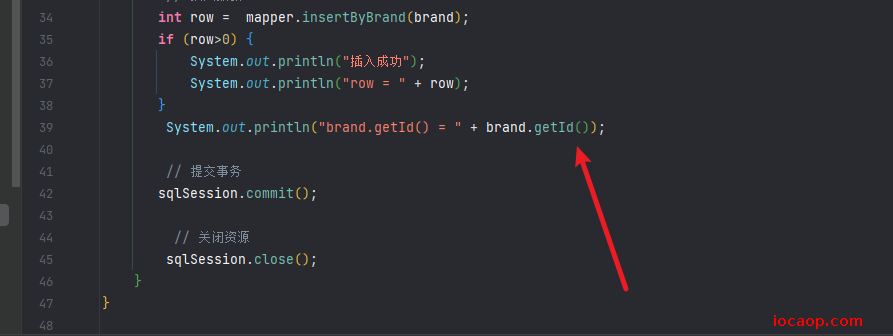

15-修改-修改全部字段
<update id="update">
update tb_brand set
brand_name = #{brandName},
company_name = #{companyName},
ordered = #{ordered},
description = #{description},
status = #{status}
where id = #{id}
</update>
16-修改-修改动态字段
<update id="updateDynamic">
update tb_brand
<set>
<if test="brandName != null and brandName != ''">
brand_name = #{brandName},
</if>
<if test="companyName != null and companyName != ''">
company_name = #{companyName},
</if>
<if test="ordered != null">
ordered = #{ordered},
</if>
<if test="description != null and description != ''">
description = #{description},
</if>
<if test="status != null">
status = #{status}
</if>
</set>
where id = #{id}
</update>
17-删除-批量删除
/**
* 批量删除
*
* @param ids id
*/
void deleteByIds(@Param("ids") List<Integer> ids);
<delete id="deleteByIds">
delete from tb_brand where id in
<foreach collection="ids" item="id" open="(" separator="," close=")">
#{id}
</foreach>
</delete>
如果在xml中的foreach的collection属性需要使用变量名称,则要加注解@Param("ids")
如果是数组,可以不加注解,在collection属性,使用array。
19-参数传递
mybatis接口可以接受各种参数:
- 单个参数
- POJO
- Map
- Collection
- 其他
- 多个参数
- 基本数据类型、String、包装类、等,需要使用
@Param注解。为什么?
- 基本数据类型、String、包装类、等,需要使用
Mybatis提供了
ParamNameResolver类来进行参数封装。
当mybatis发现接口参数是多个时,会创建Map集合,将参数封装进去,map需要对应的键值。
默认基本数据类型为:
map.put("param1",参数值1);
map.put("param2",参数值2);
如果写了@Param("key")
则会是:
map.put("key",参数值1);
看源码:ParamNameResolver类的getNamedParams方法
public Object getNamedParams(Object[] args) {
final int paramCount = names.size();
if (args == null || paramCount == 0) {
return null;
} else if (!hasParamAnnotation && paramCount == 1) {
Object value = args[names.firstKey()];
return wrapToMapIfCollection(value, useActualParamName ? names.get(0) : null);
} else {
final Map<String, Object> param = new ParamMap<>();
int i = 0;
for (Map.Entry<Integer, String> entry : names.entrySet()) {
param.put(entry.getValue(), args[entry.getKey()]);
// add generic param names (param1, param2, ...)
final String genericParamName = GENERIC_NAME_PREFIX + (i + 1);
// ensure not to overwrite parameter named with @Param
if (!names.containsValue(genericParamName)) {
param.put(genericParamName, args[entry.getKey()]);
}
i++;
}
return param;
}
}
断点调试:
先不加注解:

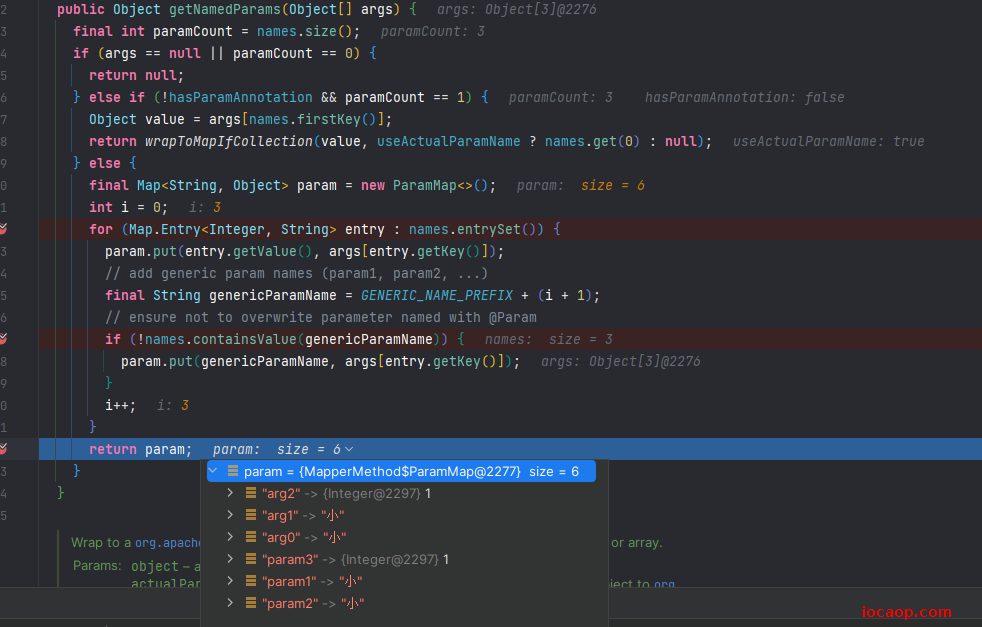
加注解:
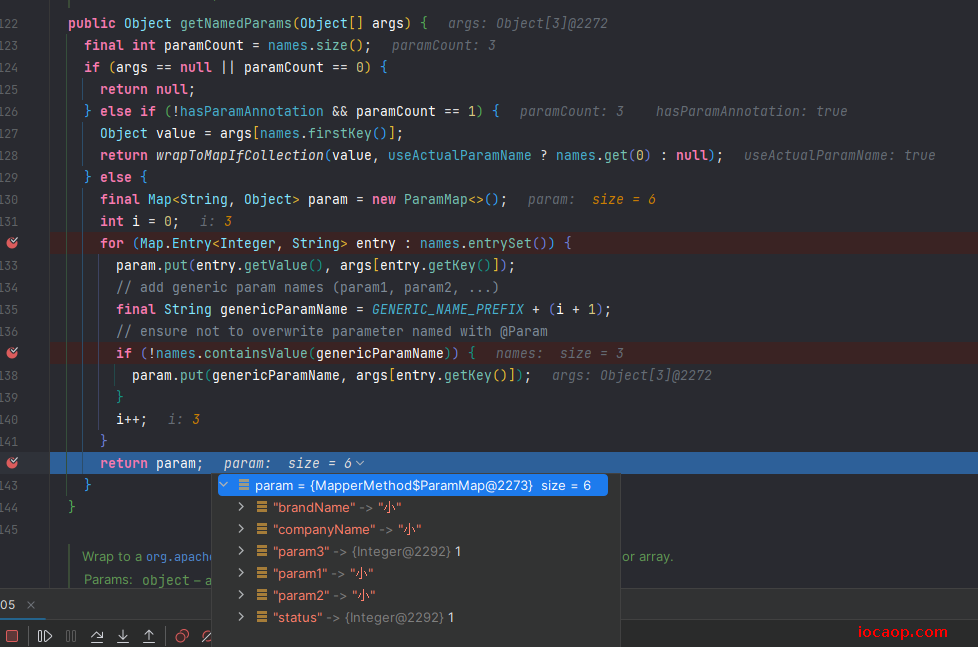
原来的arg0等被替换了。在xml中,可以使用注解指定的参数,也可以使用param1等。
如果是集合,则会走wrapToMapIfCollection方法转成map:
public static Object wrapToMapIfCollection(Object object, String actualParamName) {
if (object instanceof Collection) {
ParamMap<Object> map = new ParamMap<>();
map.put("collection", object);
if (object instanceof List) {
map.put("list", object);
}
Optional.ofNullable(actualParamName).ifPresent(name -> map.put(name, object));
return map;
} else if (object != null && object.getClass().isArray()) {
ParamMap<Object> map = new ParamMap<>();
map.put("array", object);
Optional.ofNullable(actualParamName).ifPresent(name -> map.put(name, object));
return map;
}
return object;
}
总结:
